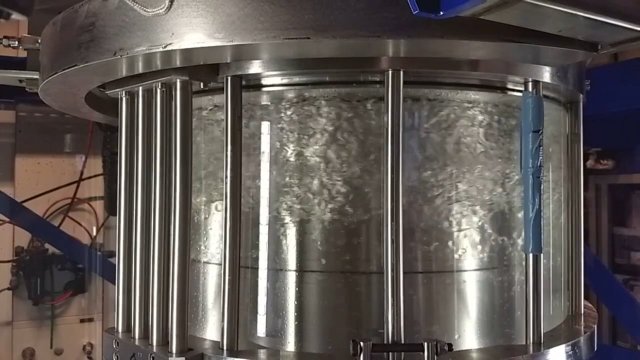When water and oil form an emulsion inside a strong turbulent flow, this emulsion consists of either water-in-oil droplets or oil-in-water droplets. The turning point between these two is spectacular, researchers of the University of Twente now show: it can make a difference of liquid friction of a factor six. The size of the droplets changes equally fast. This effect may have consequences for the transport of oil or nutrients. The paper, informally already known as ‘the mayonnaise paper’ is in Physical Review Letters and highlighted as an ‘Editor’s suggestion’.
The emulsions we know, like mayonnaise or clotted cream, stay stable by adding an emulsifier that results in the solubility of oil and water, without them separating again. In case of mayonnaise, this is egg yolk. The experiments of the UT scientists do not make use of an emulgator. Water and oil are poured inbetween the two cilinders of the Twente Turbulent Taylor Couette setup, in which turbulent flow can be creared. Initially you can see the clear line between oil and water, with oil on top. But the moment the cilinders are started turning and strong turbulent flow is inbetween, an emulsion is formed. The fluid looks a bit milky. What actually happens is that droplets are torn open and shape either oil in water or water in oil. Switching off the machine, means the emulsion vanishes rapidly. The liquid behaves, remarkably enough, in the classic Newtonian way. But there is a dramatic change when oil-in-water droplets change to water-in-oil droplets, the drag suddenly can be six times lower.
For finding out more about this mechanism, the researchers wanted to examine the droplet size using a microscope. And there, a problem immediately came in. Tapping a small sample from the turbulent liquid, would result in ending the emulsive behaviour of the sample. So, the researchers took the microscope to the liquid instead. It is a combination of a laser and a very fast camera that can register a millionth of a second. In these experiments, the researchers saw a drastic change in droplet size: exactly at the change from 'o-w' to 'w-o'.
For the food industry, but also petrochemistry and oil transport, where metastable emulsions are transported, these are valuable new insights: what, for example, would be the best oil to water ratio when pumping fluids through a pipe in which flow may get turbulent as well?
The research was done in University of Twente’s Physics of Fluids group
The paper ‘Catastrophic phase inversion in high-Reynolds number turbulent Taylor-Couette flow’, by Dennis Bakhuis, Rodrigo Ezeta, Pim Bullee, Alvaro Marin, Detlef Lohse, Chao Sun and Sander Huisman, is in Physical Review Letters.






